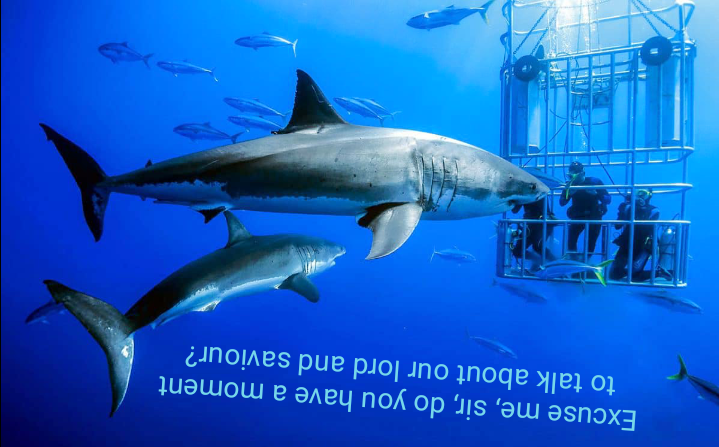
fair enough, makes sense, I was trying to think outside the box of "storing" the power as pumped hydro or batteries...but I guess where they exist, these industries still welcome the negative prices when they happen :)
There is never surplus power with a network of a few "turn it on as needed" intensive industrial uses like haber-bosch reactors for ammonia, dessalination plants and electrolysis for aluminium or other metals...right?
Permanently Deleted
At this point what they learn in business schools is the full bestiary of legal and illegal tricks and scams you can use to extract money from us cattle and contribute as little as possible to the upkeep :(
Haha, was it the endless cliff next to the gun island? Been there lmao
::: title
::: No luck yet, what's the syntax?
Subnautica...when I was so immersed that I went too deep...didn't have enough time to return to the surface to breathe...and then looked up in anguish and saw that dreaded refraction "circle" hundreds of meters above you... THE DEEP HAS YOU, THERE IS NO ESCAPE
Permanently Deleted
Deliciously thick.Credits: https://www.buzzfeed.com/bfmp/videos/109414Subscribe to BuzzFeedVideo: https://bzfd.it/2lVAsJ3BuzzFeedVideoBuzzFeed’s flagship cha...

I've found so many variations e.g.
soak for 6 hours (minimize fermentation), soak for 3 days (to maximize available nutrients and purge phytic acid);
scrub to remove skins, or don't;
change water...or don't;
blend, boil, strain;
blend, strain, boil;
boil, blend, no straining;
Boil no more than 15 minutes or it will taste like miso paste Vs 20 minutes...Vs longer because beans take a long time to cook
extra condiments or thickeners Vs just sugar.
Sooo...has anyone tried a few of these to tell me which differences to expect?
I was leaning towards soak 24h, scrub skins, boil 15m, blend (my blender is not that strong, so that's why I'm boiling first, add sugar (no straining).
Is there a configuration that is less bitter or closer to nut milk? I'm trying to understand why I am doing things, so that I can control it, otherwise I'm just following random recipes and tweaking with no idea what's happening :P
PS: https://m.youtube.com/watch?v=GWoP0lc-KqY&pp=ygUIc295IG1pbGs%3D added this recipe with the "burnt pan" trick.
It's about return on energy. Fossil fuels return 20x what you invest it's essentially free energy.
(edit: roughly, this translates to how many people are free to do things with the work of one, if every person lives alone, it's 1, if each person has a personal slave/robot, it's around 2, we want to stay well above 2. Modern society has 19 people doing all sorts of non-survival things for each one farming and collecting resources because fossil is so "cheap")
Renewables can reach 5-10 at best, which is not so bad (medieval was around 1.3, pre-industrial with slavery was around 1.8), so you can do it, but it will have to reshape society, which will be fine, if we know what we're doing or can at least imagine what we are aiming for to avoid disappointment. It's hard to be utopian going backwards.
This whole debate started with carbon footprints and carbon pricong, because I believe that creating a market can help the less virtuous among us to use their greed to help solve the problem of public consent in a consumerist society without devolving into a dictatorship.
But yea, let's aim for that energy return of say... 7 and try to imagine what such a society would look like. A return to slower shipping by sail again...more solar boilers for all hot water...solar desalination...peak-solar hydrogen for fertilizers and airplanes...more compact cities with mass transit and bikes, lots of working from home, more fixing things DIY...a return from cities to the countryside and decentralisation would help, but only if those communities were more self-sustained and local, with 2x more power to farming, mining and wind/solar communities (meaning potentially smaller countries)...now I could describe all the potential setbacks of all of those points, but I won't, because this is solarpunk and we need more imagining of what things are going to be like when we succeed...not so much the year 500 :)
It's not shying from it, many just don't see a way forward that doesn't involve a significant risk of massive suffering like starvation, war, authoritarianism if one or two things don't go exactly as the utopians would expect (like most revolutions).
This is not a utopian project, this is a "controlled landing" of a large spaceship from a 200-year old addiction to fossil-fueled growth: you need everyone on board and an awareness of the risks by everyone and possibility of relapses, calm and a notion of what is at stake, but there is still a chance that we'll fuck up, given our history :/
No, they mean the Haber process that requires energy-intensive (can mass-solar do it?) hydrogen to convert nitrogen back into ammonia.
It may work if fossil consumers like China, Japan, parts of Africa and South America, India and Europe work together to sustainably penalize and eventually get off fossil fuel dependence, but the fossil fuel exporter cartel will fight this :/
But corporations don't have any incentive to do anything that hurts the profits they extract from the 99% (mostly indexed to energy prices, everyone is selling energy directly or indirectly) and politicians at best just do what people vote for (better standard of living, which mostly depends on cheaper energy prices).
I think we're only gonna get out of this feedback loop if something drastic happens to knock most of the world's oil exports (war, some miracle UN tax on pumping oil out of the ground) or if prices start to adequately reflect carbon prices i.e. a CO2-standard that reflects the way fuels drive society and how you can't simply hide the price of your lifestyle through subsidies or diluting the future cost of pumping free energy out of the ground on everyone else.
Societies can't do it on their own without an individual blanket incentive (for all social classes) to save on CO2 emission (i.e. something like a currency). Or I guess there is maybe straight-out climate fascism, there is also that solution to this tragedy of commons, but I'd like to try to avoid that.
Heya fellow raccoon, raccoon Bible is much better than the one compiled by Roman bishops in 325AD in Nicea e.g. "let there be trash for all" and "give to racoons what belongs to the raccoons" :D
Yes, but corporations make things for the 99%. Or maybe you mean things outside mainstream society, like private jets, all sorts of military manufacture and upkeep and space vanity projects...I have a hard time understanding what it is that corporations are responsible for that their customers are not responsible for as well.
It's not a drop in the bucket. Not driving, not flying has a major impact, but sure if 1% of people hoard 50% of the ability to emit CO2 and other scarce resources, that's something else that needs to be fixed, but carbon pricing in terms of a footprint or an actual number under every price tag makes sense nevertheless.
Makes sense I didn't get the job, I only vaguely know the difference and it was mostly theoretical stuff like CI/CD, but those recruiters really wanted to throw me at random interviews to see if I'd stick :D
PS: sorry I offtopic'ed to recruiter-hating, gonna go find a community for that.
You mean conspicuous consumption or things like "being the loser who doesn't own a car, but actually walks to work and saves tons in gas"
Who do companies sell shit to? Where do they get their profits from? Why do they even exist?
NATO says it's "actively addressing incidents" but not to worry about the bombs dropping anytime soon.

A new solar desalination system takes in saltwater and heats it with natural sunlight. The system flushes out accumulated salt, so replacement parts aren’t needed often, meaning the system could potentially produce drinking water that is cheaper than tap water.

> Engineers at MIT and in China are aiming to turn seawater into drinking water with a completely passive device that is inspired by the ocean, and powered by the sun.
> In a paper appearing today in the journal Joule, the team outlines the design for a new solar desalination system that takes in saltwater and heats it with natural sunlight.
> The researchers estimate that if the system is scaled up to the size of a small suitcase, it could produce about 4 to 6 liters of drinking water per hour and last several years before requiring replacement parts. At this scale and performance, the system could produce drinking water at a rate and price that is cheaper than tap water.
https://www.cell.com/joule/fulltext/S2542-4351(23)00360-4
Local human rights officials say at least 27 people, including two civilians, have been killed after Azerbaijan attacked Armenian-controlled areas

India News: India-Middle East-Europe Economic Corridor, announced at G20, gives New Delhi new purchase in West Asia. But a lot will depend on delivery, and India’

India-Middle East-Europe Economic Corridor, announced at G20, gives New Delhi new purchase in West Asia. But a lot will depend on delivery, and India’s economic performance
The spectacular G20 summit in New Delhi could be termed as India’s coming out party. Not dissimilar to the 2008 Summer Olympics in Beijing, which was widely seen as China’s grand message of “arrival”. Curiously, in many aspects of national power, China 2008 and India 2023 have several analogues – not least in aggregate GDP measures, where China 2007 and India 2022 are at very similar levels! Perhaps not entirely coincidentally, the biggest brass-tacks outcome of G20 was the India-Middle East-Europe Economic Corridor (IMEE-EC). A multi-modal connectivity initiative to link India with Europe via ports and rail corridors built in the Middle East (ME). It will, in theory, provide an alternative to the current trade connectivity through the Suez Canal. In conception and design, it looks to be an alternative to China’s ambitious BRI. An Indian
BRI
(Boats and Rail Initiative) to challenge China’s BRI? Sounds compelling beyond the wordplay, especially as China’s BRI runs into rough weather, including in the Indian subcontinent, primarily on financial sustainability issues.
I was going through the modlog today and found that this comment posted to lemmy.ml was simply removed for being "reactionary".
> Removed Comment What reform of France's educational establishment would satisfy you? Should they move their weekends to Mondays and Tuesdays in order to avoid accidentally aligning with any religious practice's day of rest? This is a ridiculous standard to hold any societal institution to. Because France's dominant culture has been Christian for many years, its secular institutions of course have echoes of Christian practice within them - but this is not proof that they are Christian institutions. Education is good. Education should be given to every single person in society, and every person in it should have a right to receive a full secular education regardless of their parents' opinion on the matter. And during the course of that education, class, ethnic, and religious differences between children should be minimized in order to socialize children into being tolerant, metropolitan citizens. reason: reactionary
That sounds like a perfectly respectable position to have, even if it may be a little controversial, but it is more constructive than divisive. I really like lemmy's transparency in showing what was removed and why, but for the first time I'm seeing what looks like a summary removal of an urbane comment.
Am I the only one who is worried by that? Am I missing something here?
By the way, I'm not interested in debating the subject, there is plenty of debate in the original post, what I want to know is how any of you would frame this as decisively reactionary enough to throw out of a healthy debate when comparing with the flood of shitposting we see every day that doesn't get struck down.

https://feddit.nl/comment/2555047
Europe's carmakers have a fight on their hands to produce lower-cost electric vehicles (EVs) and erase China's lead in developing cheaper, more consumer-friendly models, executives said at Munich's IAA mobility show.

Main points (to make up for the clickbaity title):
Challenge to bring down European EV manufacturing costs
Lower costs to close price gap with China EVs
China EV sales account for 8% of European total through July
Renault's R5 EV to be 25%-30% cheaper than Scenic/Megane
MUNICH, Sept 4 (Reuters) - Europe's carmakers have a fight on their hands to produce lower-cost electric vehicles (EVs) and erase China's lead in developing cheaper, more consumer-friendly models, executives said at Munich's IAA mobility show.
"We have to close the gap on costs with some Chinese players that started on EVs a generation earlier," Renault (RENA.PA) CEO Luca de Meo told Reuters at the car show, adding when manufacturing costs decline, prices will also go down.
...continues
The work has potential military applications, say experts

The empty auditoriums, Gila monsters, resistant pharmaceutical executives and enigmas that led to Ozempic and other drugs that may change how society thinks about obesity.

We Know Where New Weight Loss Drugs Came From, but Not Why They Work
The empty auditoriums, Gila monsters, resistant pharmaceutical executives and enigmas that led to Ozempic and other drugs that may change how society thinks about obesity.
Credit...Ryan David Brown for The New York Times
Gina Kolata
For more than 25 years, Gina Kolata has been reporting on obesity research that until recently had found that drugs and changes in diet or exercise produced little lasting effect on weight.
Aug. 17, 2023Updated 9:47 a.m. ET
Every so often a drug comes along that has the potential to change the world. Medical specialists say the latest to offer that possibility are the new drugs that treat obesity — Ozempic, Wegovy, Mounjaro and more that may soon be coming onto the market.
It’s early, but nothing like these drugs has existed before.
“Game changers,” said Jonathan Engel, a historian of medicine and health care policy at Baruch College in New York.
Obesity affects nearly 42 percent of American adults, and yet, Dr. Engel said, “we have been powerless.” Research into potential medical treatments for the condition led to failures. Drug companies lost interest, with many executives thinking — like most doctors and members of the public — that obesity was a moral failing and not a chronic disease.
While other drugs discovered in recent decades for diseases like cancer, heart disease and Alzheimer’s were found through a logical process that led to clear targets for drug designers, the path that led to the obesity drugs was not like that. In fact, much about the drugs remains shrouded in mystery. Researchers discovered by accident that exposing the brain to a natural hormone at levels never seen in nature elicited weight loss. They really don’t know why.
“Everyone would like to say there must be some logical explanation or order in this that would allow predictions about what will work,” said Dr. David D’Alessio, chief of endocrinology at Duke, who consults for Eli Lilly among others. “So far there is not.”
Although the drugs seem safe, obesity medicine specialists call for caution because — like drugs for high cholesterol levels or high blood pressure — the obesity drugs must be taken indefinitely or patients will regain the weight they lost.
Dr. Susan Yanovski, a co-director of the office of obesity research at the National Institute of Diabetes and Digestive and Kidney Diseases, warned that patients would have to be monitored for rare but serious side effects, especially as scientists still don’t know why the drugs work.
But, she added, obesity itself is associated with a long list of grave medical problems, including diabetes, liver disease, heart disease, cancers, sleep apnea and joint pain.
“You have to keep in mind the serious diseases and increased mortality that people with obesity suffer from,” she said.
The drugs can cause transient nausea and diarrhea in some. But their main effect is what matters. Patients say they lose constant cravings for food. They find themselves satisfied with much smaller portions. They lose weight because they naturally eat less — not because they burn more calories.
And results from a clinical trial reported last week indicate that Wegovy can do more than help people lose weight — it also can protect against cardiac complications, like heart attacks and strokes.
But why that happens remains poorly understood.
“Companies don’t like the term trial and error,” said Dr. Daniel Drucker, who studies diabetes and obesity at the Lunenfeld-Tanenbaum Research Institute in Toronto and who consults for Novo Nordisk and other companies. “They like to say, ‘We were extremely clever in the way we designed the molecule,” Dr. Drucker said.
But, he said, “They did get lucky.” A Lonely Origin Story
Image Dr. Joel Habener stands in a lab in a white coat holding a glass slide. Dr. Joel Habener in 2007.Credit...Ruby Arguilla-Tull/Bloomberg News
In the 1970s, obesity treatments were the last thing on Dr. Joel Habener’s mind. He was an academic endocrinologist starting his own lab at Harvard Medical School and looking for a challenging, but doable, research project.
He chose diabetes. The disease is caused by high blood sugar levels and is typically treated with injections of insulin, a hormone secreted by the pancreas that helps cells store sugar. But an insulin injection makes blood sugar plummet, even if levels are already low. Patients have to carefully plan injections because very low blood sugar levels can result in confusion, shakiness and even a loss of consciousness.
Two other hormones also play a role in regulating blood sugar — somatostatin and glucagon — and little was known then about how they are produced. Dr. Habener decided to study the genes that direct cells to make glucagon.
That led him to a real surprise. In the early 1980s, he discovered a hormone, GLP-1, that exquisitely regulates blood sugar. It acts only on insulin-producing cells of the pancreas, and only when blood sugar rises too high.
It was perfect, in theory, as a targeted treatment to replace sledgehammer-like insulin injections.
Another researcher, Dr. Jens Juul Holst at the University of Copenhagen, independently stumbled on the same discovery.
But there was a problem: When GLP-1 was injected, it vanished before reaching the pancreas. It needed to last longer.
Dr. Drucker, who led the GLP-1 discovery efforts on Dr. Habener’s team, labored for years on the challenge. It was, he said, “a pretty lonely field.”
When he applied to the Endocrine Society to give talks, he found himself scheduled at the very end of the last day of the annual meetings.
“Everyone had left for the airport — people were taking down the exhibits,” he said.
From the late 1980s to the early 1990s, he spoke to nearly empty auditoriums. Dr. Eng’s Monster
Image Credit...Peter DaSilva for The New York Times
Success came from a chance discovery that was not appreciated at the time.
In 1990, John Eng, a researcher at the Veterans Affairs medical center in the Bronx, was looking for interesting new hormones in nature that might be useful for medications in people.
He was drawn to the venomous Gila monster when he learned that it somehow kept its blood sugar levels stable when it did not have much to eat, according to a report from the National Institutes of Health, which funded his work. So Dr. Eng decided to search for chemicals in the lizards’ saliva. He found a variant of GLP-1 that lasted longer.
Dr. Eng told The New York Times in 2002 that the V.A. had declined to patent the hormone. So Dr. Eng patented it himself and licensed it to Amylin Pharmaceuticals, which began testing it as a diabetes drug. The drug, exenatide or Byetta, went on sale in the United States in 2005.
But Byetta had to be injected twice a day, a real disincentive to its use. Drug company chemists sought even longer-lasting versions of GLP-1.
At Novo Nordisk, chemists began by using a well-known trick. They loosely attached GLP-1 to a blood protein that kept it stable enough to remain in circulation for at least 24 hours. But when GLP-1 slips off the protein, enzymes in the blood quickly degrade it. So chemists had to alter the hormone’s building blocks — a chain of amino acids — to find a more durable variant.
After tedious trial and error, Novo Nordisk produced liraglutide, a GLP-1 drug that lasted long enough for daily injections. They named it Victoza, and the F.D.A. approved it as a treatment for diabetes in 2010.
It had an unexpected side effect: slight weight loss. A Dismal History
Image Dr. Jeffrey Friedman, who discovered the hormone that tells the brain how much fat is on the body, in 1995.Credit...Remi Benali/Gamma-Rapho, via Getty Images
Obesity had become a dead end in the pharmaceutical industry. No drug that was tried worked very well, and every one that led to even modest weight loss had serious side effects.
For a flickering moment in the late 1990s, there was hope when Dr. Jeffrey Friedman at Rockefeller University in New York found a hormone that told the brain how much fat was on the body. Lab mice genetically modified to have none of the hormone ate voraciously and grew enormously fat. Researchers could fine-tune an animal’s weight by altering how much of the hormone it got.
Dr. Friedman named the hormone leptin. Amgen bought the rights to leptin and, in 1996, began testing it in people. They did not lose weight.
Dr. Matthias Tschöp at Helmholtz Munich in Germany tells of the frustration. He left academia three decades ago to work at Eli Lilly in Indianapolis, excited by leptin and determined to use science to find a drug for weight loss.
“I was so inspired,” Dr. Tschöp said.
When leptin failed, he tried a different gut hormone, ghrelin, whose effects were the opposite of leptin’s. The more ghrelin an animal had, the more it would eat. Perhaps a drug that blocked ghrelin would make people lose weight.
“Again, it wasn’t that simple,” said Dr. Tschöp, who left Lilly in 2002.
The body has so many redundant circuits of interacting nerve impulses and hormones to control weight that tweaking one simply did not make a difference.
And there was another obstacle, noted Dr. Tschöp’s former colleague at Lilly, Dr. Richard Di Marchi, who also was an executive at Novo Nordisk.
“There was very little interest in the industry in doing this,” said Dr. Di Marchi, now at Indiana University. “Obesity was not thought to be a disease. It was looked at as a behavioral problem.”
Image Dr. Friedman studied mice that had been genetically modified to have none of a hormone that told their brains how much fat was on their bodies. Researchers could fine-tune an animal’s weight by altering its hormones, but the study failed in humans.Credit...Remi Benali/Gamma-Rapho, via Getty Images Starving Rats
Novo Nordisk, which today has 45.7 percent of the global insulin market, thought of itself as a diabetes company. Period.
But one company scientist, Lotte Bjerre Knudsen, could not stop thinking about tantalizing results from studies with liraglutide, the GLP-1 drug that lasted long enough to be injected just once a day.
In the early 1990s, Novo researchers, studying rats implanted with tumors of pancreas cells that produced copious amounts of glucagon and GLP-1, noticed that the animals had nearly stopped eating.
“These rats, they starved themselves,” Dr. Knudsen said in a video series released by the Novo Nordisk Foundation. “So we kind of knew there was something in some of these peptides that was really important for appetite regulation.”
Other studies by academic researchers found that rats lost their appetites if GLP-1 was injected into their brains. Human subjects who got an intravenous drip of GLP-1 ate 12 percent less at a lunch buffet than those who got a placebo.
So why not study liraglutide as both a diabetes drug and an obesity drug, Dr. Knudsen asked.
She faced resistance in part because some company executives were convinced that obesity resulted from a lack of willpower. One of the champions of investigating GLP-1 for weight loss, Mads Krogsgaard Thomsen, the current chief executive of the Novo Nordisk Foundation and former chief scientific officer of the company, said in the video posted by the foundation that he “had to spend half a year convincing my C.E.O. that obesity is not just a lifestyle condition.”
Dr. Knudsen also noted that the company’s business division had struggled with the idea of promoting liraglutide for two distinct purposes.
“It’s either diabetes, or it’s a weight loss,” she recalled in the foundation video series.
Finally, after liraglutide was approved in 2010 for diabetes, Dr. Knudsen’s proposal to study the drug for weight loss moved forward. After clinical trials, the F.D.A. approved it as Saxenda for obesity in 2014. The dose was about twice the diabetes dose. Patients lost about 5 percent of their weight, a modest amount.
But Dr. Martin Holst Lange, executive vice president of development at Novo Nordisk, said in a telephone interview that it was at least as good as other weight-loss drugs, and without side effects like heart attacks, strokes and death.
“We were super excited,” he said. Beyond Diabetes
Image A Novo Nordisk site outside Copenhagen.Credit...Scanpix Denmark/Reuters
Despite the progress on weight loss, Novo Nordisk continued to focus on diabetes, trying to find ways to make a longer-lasting GLP-1 so patients would not have to inject themselves every day.
The result was a different GLP-1 drug, semaglutide, that lasted long enough that patients had to inject themselves only once a week. It was approved in 2017 and is now marketed as Ozempic.
It also caused weight loss — 15 percent, which is three times the loss with Saxenda, the once-a-day drug, although there was no obvious reason for that. Suddenly, the company had what looked like a revolutionary treatment for obesity.
But Novo Nordisk could not market Ozempic for weight loss without F.D.A. approval for that specific use.
In 2018, a year after Ozempic’s approval for diabetes, the company started a clinical trial. In 2021, Novo Nordisk got approval from the F.D.A. to market the same drug for obesity with a weekly injection at a higher maximum dose. It named the drug Wegovy.
But even before Wegovy was approved, people had begun taking Ozempic for obesity. Novo Nordisk, in its Ozempic commercials, mentioned that many taking it lost weight.
Hinting turned out to be more than enough. Soon, said Dr. Jeffrey Mechanick, an endocrinologist at Mount Sinai’s Icahn School of Medicine, patients latched onto Ozempic. Doctors prescribed it off label for those who did not have diabetes.
“There was a little bit of gaming going on,” Dr. Mechanick said, with some doctors coding patients as having pre-diabetes to help them get insurance coverage.
By 2021, fed by social media, a general frenzy for weight loss and aggressive marketing by Novo Nordisk, the news that Ozempic made people lose weight had reached a tipping point, said Dr. Caroline Apovian, a co-director of the Center for Weight Management and Wellness at Brigham and Women’s Hospital and a consultant for Novo Nordisk and other companies. Ozempic was on everyone’s lips, even though Wegovy was the drug approved that year for obesity.
But Wegovy caught up.
In July, doctors in the U.S. wrote about 94,000 prescriptions a week for Wegovy compared with about 62,000 a week for Ozempic. Wegovy is in such demand, though, that the company is unable to make enough, its spokeswoman Ambre James-Brown said. So for now, while it ramps up production, the company sells the drug only in Norway, Denmark, Germany and the United States. And at pharmacies in those countries, shortages are frequent.
And Dr. Apovian, like many other obesity medicine specialists, is now booked with patients a year in advance.
Image Credit...Cydni Elledge for The New York Times More Medicines, More Mysteries
The reason Ozempic and Wegovy are so much more effective than Saxenda remains a mystery. Why should a once-a-week injection produce much more weight loss than a once-a-day injection?
The drugs, said Randy Seeley, an obesity researcher at the University of Michigan, are not correcting for a lack of GLP-1 in the body — people with obesity make plenty of GLP-1. Instead, the drugs are exposing the brain to hormone levels never seen in nature. Patients taking Wegovy are getting five times the amount of GLP-1 that they would produce in response to a Thanksgiving dinner, Dr. Seeley said.
And, he added, in the brain, “the drugs go to unusual places.” They are not just going to areas thought to control overeating.
“If you were designing a drug, you would say that’s a bad idea,” said Dr. Seeley, who has consulted for Novo Nordisk and Eli Lilly, among others. Drug designers try for precision — a drug should go only to the cells where it is needed.
GLP-1, because of its chemical structure, should not even get into some areas of the brain where it slips in.
“Nobody understands that,” Dr. Seeley said.
Wegovy, though, is just the start.
Lilly’s diabetes drug, tirzepatide or Mounjaro, is expected to get F.D.A. approval for obesity this year. It hooks GLP-1 to another gut hormone, GIP.
GIP, on its own, produces, at best, a modest weight loss. But the two-hormone combination can allow people to lose a median of about 20 percent of their weight.
“No one fully understands why,” Dr. Drucker said.
Lilly has another drug, retatrutide, that, while still in early stages of testing, seems to elicit a median 24 percent weight loss.
Amgen’s experimental drug, AMG 133, could be even better, but is even more of a puzzle. It hooks GLP-1 to a molecule that blocks GIP.
There is no logical explanation for why seemingly opposite approaches would work.
Researchers continue to marvel at these biochemical mysteries. But doctors and patients have their own takeaway: The drugs work. People lose weight. The constant chatter in their brains about food and eating is gone.
And, while the stigma of obesity and the cultural stereotype that obese people aren’t trying hard enough to lose weight endures, some experts are optimistic. Now, they say, patients no longer have to blame themselves or feel like failures when they can’t lose weight.
“The era of ‘just go out and diet and exercise’ is now gone,’” said Dr. Rudolph Leibel, a professor of diabetes research at Columbia University Irving Medical Center. “Now clinicians have tools to address obesity.”
A correction was made on
Aug. 17, 2023
:
An earlier version of this article misstated the name of a drug approved for diabetes in 2010. It was Victoza, not Saxenda. It also misattributed a quote from a video about persuading a chief executive that obesity was not just a lifestyle condition. It was said by Mads Krogsgaard Thomsen, not Lars Rebien Sorensen.
One of the best ways to determine different species of sharks is by looking at their fins. Learn all about them from the experts at SharkSider.com.
Large earthquakes occurring worldwide have long been recognized to be non Poisson distributed, so involving some large scale correlation mechanism, which could be internal or external to the Earth. Till now, no statistically significant correlation of the global seismicity with one of the possible m...

Abstract: Large earthquakes occurring worldwide have long been recognized to be non Poisson distributed, so involving some large scale correlation mechanism, which could be internal or external to the Earth. Till now, no statistically significant correlation of the global seismicity with one of the possible mechanisms has been demonstrated yet. In this paper, we analyze 20 years of proton density and velocity data, as recorded by the SOHO satellite, and the worldwide seismicity in the corresponding period, as reported by the ISC-GEM catalogue. We found clear correlation between proton density and the occurrence of large earthquakes (M > 5.6), with a time shift of one day. The significance of such correlation is very high, with probability to be wrong lower than 10–5. The correlation increases with the magnitude threshold of the seismic catalogue. A tentative model explaining such a correlation is also proposed, in terms of the reverse piezoelectric effect induced by the applied electric field related to the proton density. This result opens new perspectives in seismological interpretations, as well as in earthquake forecast.
Abstract: Investigating the early-stage evolution of an erupting flux rope from the Sun is important to understand the mechanisms of how it looses its stability and its space weather impacts. Our aim is to develop an efficient scheme for tracking the early dynamics of erupting solar flux ropes and use the algorithm to analyse its early-stage properties. The algorithm is tested on a data-driven simulation of an eruption that took place in active region AR12473. We investigate the modelled flux rope's footpoint movement and magnetic flux evolution and compare with observational data from the Solar Dynamics Observatory's Atmospheric Imaging Assembly in the 211 Å and 1600 Å channels. To carry out our analysis, we use the time-dependent data-driven magnetofrictional model (TMFM). We also perform another modelling run, where we stop the driving of the TMFM midway through the flux rope's rise through the simulation domain and evolve it instead with a zero-beta magnetohydrodynamic (MHD) approach. The developed algorithm successfully extracts a flux rope and its ascend through the simulation domain. We find that the movement of the modelled flux rope footpoints showcases similar trends in both TMFM and relaxation MHD run: they recede from their respective central location as the eruption progresses and the positive polarity footpoint region exhibits a more dynamic behaviour. The ultraviolet brightenings and extreme ultraviolet dimmings agree well with the models in terms of their dynamics. According to our modelling results, the toroidal magnetic flux in the flux rope first rises and then decreases. In our observational analysis, we capture the descending phase of toroidal flux. In conclusion, the extraction algorithm enables us to effectively study the flux rope's early dynamics and derive some of its key properties such as footpoint movement and toroidal magnetic flux.
Abstract: The solar atmosphere is known to contain many different types of wavelike oscillation. Waves and other fluctuations (e.g., turbulent eddies) are believed to be responsible for at least some of the energy transport and dissipation that heats the corona and accelerates the solar wind. Thus, it is important to understand the behavior of magnetohydrodynamic (MHD) waves as they propagate and evolve in different regions of the Sun’s atmosphere. In this paper, we investigate how MHD waves can affect the overall plasma state when they reflect and refract at sharp, planar interfaces in density. First, we correct an error in a foundational paper (Stein 1971) that affects the calculation of wave energy-flux conservation. Second, we apply this model to reflection-driven MHD turbulence in the solar wind, where the presence of density fluctuations can enhance the generation of inward-propagating Alfven waves. This model reproduces the time-averaged Elsasser imbalance fraction (i.e., ratio of inward to outward Alfvenic power) from several published numerical simulations. Lastly, we model how the complex magnetic field threading the transition region between the chromosphere and corona helps convert a fraction of upward-propagating Alfven waves into fast-mode and slow-mode MHD waves. These magnetosonic waves dissipate in a narrow region around the transition region and produce a sharp peak in the heating rate. This newly found source of heating sometimes exceeds the expected heating rate from Alfvenic turbulence by an order of magnitude. It may explain why some earlier models seemed to require an additional ad-hoc heat source at this location.
Marine biologists have spotted an intriguing behavior of fish chafing themselves against a shark's skin in over a dozen locations worldwide. What could be the possible ecological function of this serving both species?
Turns out schools of fish hang out around sharks to use their skin as an exfoliator 🤣 and to tag along and save energy.

Fact# 30.
Sharks use heartbeats to follow their prey. Sharks have nodules on the nose called ampullae of Lorenzini. They can sense electricity with these nodules, therefore the electrical pulse that comes from a beating heart acts like a signal for close by sharks. Fact# 29.
No one can see their ears, and that doesn’t stop them from being able to hear us from more than 2 football fields away. That’s because sharks have inner ears only, using them they can track the sound of the prey from a distance of 800 feet or more. Fact# 28.
This one is the interesting facts about sharks, if you see a shark circling and wonder if it’s about to attack a prey, here is the clue: The shark would hunch its back, lower the pectoral fins (near its belly) and whirl in crisscross motions.30 Interesting Facts about Sharks-shark circling Fact# 27.
Unlike human beings, who have their upper jaw fixed on the skull, a shark can stick out and dislocate its upper jaw to grab and retain its prey. Fact# 26.
Sharks come from a family of fish that have cartilage skeletons made of a tissue which is lighter and more flexible than bones.
Also explore Amazing Facts About Blue Whales Fact# 25.
This is the amazing facts about sharks that they have an amazing sense of smell, so strong that they can sense a single drop of blood in an olympic-size pool. Fact# 24.
Sharks breathe with a series of 5 to 7 gill slits on either side of their bodies. Fact# 23.
Sharks are able to see in muddy water because of a special characteristic that makes their eyes extra sensitive to light. A membrane on the back of the eye called tapetum lucidum reflects back sunlight into the eye; as a result sharks can make more use of slightest light available. Fact# 22.
Volusia County has reportedly had more shark attacks than anywhere else in the entire world. Here 210 attacks have been reported since 1882. However 90% of these were just bites with low figures of fatalities. Fact# 21.
Great white sharks are fussy eaters. Their diet needs lots of fat and after 1 bite a great white shark decides whether that meal will satisfy its dietary needs. If it doesn’t, then the shark will swim away leaving the rest.30 Interesting Facts about Sharks-Great white sharks are fussy eaters Fact# 20.
The surprising faacts about sharks is the mega-mouth shark wasn’t discovered until 1976, with just 41 known sightings of the species till now. The mega-mouths much like whale sharks are filter-feeders having huge jaws which extend beyond their eyes.30 Interesting Facts about Sharks-mega-mouth shark Fact# 19.
Sharks have more senses than humans. Sharks can sense pressure waves and because of that they are able to detect both movement and direction of an object. Fact# 18.
Sharks constantly shed their teeth. Shark teeth are inexpensive yet popular beach souvenirs.30 Interesting Facts about Sharks-shark teeth Fact# 17.
The whale sharks are the largest species, and the pygmy sharks are the tiniest! They measure approximately 8 inches in length and can make light on their own (this helps them to hunt underwater). Fact# 16.
Hammerhead shark is a new species which was discovered in 2006 by DNA testing. An official verification is still awaited.30 Interesting Facts about Sharks-Hammerhead shark Fact# 15.
Another interesting facts about Sharks move like planes! They create forward movement by moving their tail, which works like a propeller. As sharks move forward, water moves over their fins as if they were wings.
Also get to know about Top 10 Amazing Megalodon Facts Fact# 14.
Their liver contains lots of oil, which makes their liver a somewhat buoyant organ, which helps in keeping their balance underwater. Fact# 13.
Sharks can be tracked with geographic profiling. Geographic profiling pins down locations where attacks may occur, though attacks are generally uncommon. Fact# 12.
Hammerhead sharks are well-known for their unusually shaped head, called cephalofoils, which makes them superior hunters.30 Interesting Facts about Sharks-Hammerhead sharks Fact# 11.
Sharks are susceptible to moon’s control of ocean tides. Moon’s phase affects their eating habits and draws them close to shore. Fact# 10.
Shark lives up to 25 years on an average, however some can grow to be as old as 100! Fact# 9.
Surfers are more probable to die by drowning rather than from a shark attack. Fact# 8.
Amother amazing facts about sharks are Great white sharks consume eleven tons of food per year! Fact# 7.
The tooth shaped skin of sharks called denticles, allow them to move quickly through water without getting algae and barnacles deposits on their skin.30 Interesting Facts about Sharks-shark denticles Fact# 6.
We may think of sharks as voracious, man-eaters, however in actuality, only 3% of above 500 species are known to have attacked humans. 30 Interesting Facts about Sharks-human attack Fact# 5.
Sharks respond “yummy hum” sound injured fish make this sound attracts sharks towards injured fishes; it is an infrasonic sound which humans can’t hear.30 Interesting Facts about Sharks-yummy humm Fact# 4.
Nearly 50 species of different sharks have a light emitting organ called photospheres. They use it to attract mates.30 Interesting Facts about Sharks-photosphere
Fact# 3.
This one is another interesting facts about Female sharks can even reproduce without contact from a male shark, this act is called parthenogenesis.30 Interesting Facts about Sharks-parthenogenesis Fact# 2.
Sharks living in frosty waters heat their eyes with a special organ in their eye socket. This enables them to hunt even in extreme temperatures.30 Interesting Facts about Sharks-shark eye Fact# 1.
The gestation period of a pregnant shark can is anywhere from 5 months to 2 years. (e.g. pregnant shark lady in the image)
The Royal Ontario Museum (ROM) announces the oldest swimming jellyfish in the fossil record with the newly named Burgessomedusa phasmiformis. These findings are announced in the journal Proceedings of the Royal Society B.

Incredible how these animals are so tenuous and can still leave a fossil record



